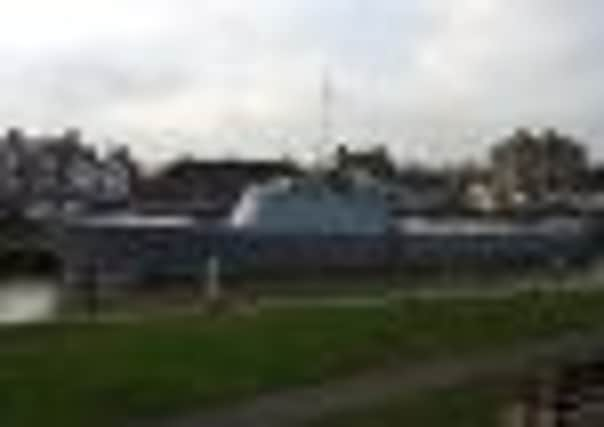Rye boat’s heroic past


Restoring the Fairmile B motor launch has been a labour of love for restoration expert and historian Robert Portsmouth.
He explained: “Given that the sight and sounds of a ship, especially a warship, being professionally restored and made ready for sea has long been a rare sight in Rye, barely an hour has passed without a curious and always complimentary visitor interrupting the work to ask me more about what has become known as that ‘big motor torpedo boat on the Strand’.
Advertisement
Hide AdAdvertisement
Hide Ad“It is perhaps time I provided a little more detail for a wider audience. It is in fact a Royal Navy Fairmile B motor launch, formerly H. M. ML 526, and while the name ‘Fairmile’ doesn’t have the same heroic connotations as ‘MTB’, they were highly active in a variety of challenging roles during the Second World War and played an equally ‘heroic’ part.
“Designed in 1940 along the lines of the fast contemporary destroyers, they were prefabricated by Noel Macklin’s Cobham based Fairmile company in an innovative ‘flat-pack’ form and transported to small boatyards around the country to be rapidly assembled and put into service defending Britain during the first beleaguered years of the war.
“Initially designated for anti-submarine work and mine-laying, their twin 650 bhp Hall-Scott petrol engines pushing a light wooden hull gave them a top speed of almost twenty-five miles an hour. Although this was some ten mph slower than the shorter and lighter MTBs, the Fairmile’s greater size (34m long, 5.56m wide, and drawing just under 1.47m), meant they were soon being used in a variety of roles where a fast and easily adaptable ship was needed that had a greater range and capacity than an MTB.
“Some did serve as motor torpedo boats, equipped with heavy 21 inch American torpedoes. Others served as small destroyers escorting coastal convoys, mine clearing, harbour defence and rescuing downed pilots from enemy waters. “They were also active in clandestine operations: transporting SOE agents to and from the coast of occupied Europe, particularly Holland, Norway and Brittany, and in May 1944, Fairmiles enjoyed the equally dangerous honour of serving as scouts and pathfinders for the D-Day landings.
Advertisement
Hide AdAdvertisement
Hide Ad“Their most famous contribution, however, was as assault vessels for the commando raids such as the famous ones on Dieppe and St Nazaire, where a fleet of sixteen Fairmiles carried commandoes through a hail of German fire to successfully blow up the dry dock and then valiantly remained to cover their landing and evacuate survivors.
“As with many of the riskiest wartime occupations, most of the crews were young volunteers, comprising two officers (usually RNVR), two petty officers and 12 to 14 ratings with an average age of 22. All of which helped develop a strong sense of camaraderie and pride in their ships. Something needed in abundance, for although the Fairmiles were fairly well armed, with a two or three pound breech loading gun and/or a 20mm Oerlikon cannon, depth charges aft, and twin Lewis, Vickers or Bren Guns on the wheelhouse, their 45mm thick double diagonal mahogany hulls offered no effective protection. Furthermore, there was the constant danger that the hundreds of gallons of petrol they carried would be ignited by enemy fire, and only three of the St Nazaire Fairmiles made it back to England, leaving most of the others blazing to their waterlines.
Approximately 650 were built between 1940 and 1945. Most in the British Isles, but some 140 or so in Canada, India, New Zealand, South Africa, Australia - with eight even being acquired by the U.S. Navy in a reverse form of ‘lease-lend’ and put into service as submarine chasers on the East Coast.
“In the case of ML 526, she was built on the Hamble river, launched in August 1942, and although probably not used for commando raids, she had a highly active war with the Falmouth based 63rd flotilla and as a hospital launch operating out of Newhaven.
Advertisement
Hide AdAdvertisement
Hide Ad“Her owners, Sandy and David Brooker-Carey, who have organised and funded the project to fully restore 526 to her wartime specification for educational purposes, are still conducting research, but there are suggestions that she was also used by SOE for covert operations.
“Sold by the Admiralty in 1946, she ended up in the Mediterranean renamed the ‘Anbrigo’, and, apparently, continued with the kind of freelance ‘covert’ operations once traditional in Rye: smuggling between Tangiers and Gibraltar until 1949 when she was captured and impounded by the Royal Navy’s Admiralty Marshal.
“Returned to England, she was purchased by a Devonshire ferry company and spent the next fifty years much more pacifically as the ‘Western Lady IV’ carrying summer holidaymakers across Torbay.
“If all goes to plan, then this time next year ML 526 should be restored to her former glory, and although bristling with armaments (decommissioned) ready at the age of seventy-one to begin a new career in historical maritime education as probably the largest serviceable World War II Royal Naval vessel in the UK.”
Robert Portsmouth specialises in the restoration of historical and traditional boats and lectures part-time in history at the National University of Ireland, Galway.